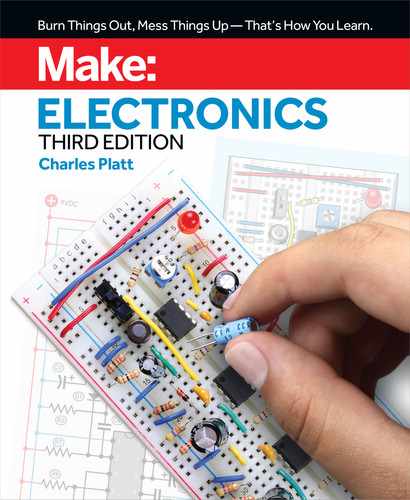0%
80Chapters
0-1Hours read
0kTotal Words
Make: Electronics explores the properties and applications of discrete components that are the fundamental building blocks of circuit design. Understanding resistors, capacitors, transistors, inductors, diodes, and integrated circuit chips is essential even when using microcontrollers. Make: Electronics teaches the fundamentals and also provides advice on the tools and supplies that are necessary. Component kits are available, specifically developed for the third edition.
Table of Contents
- Table of Contents
- Introduction: How to Have Fun with This Book
- Section One: The Basics (1/2)
- Section One: The Basics (2/2)
- Section Two: Switching (1/2)
- Section Two: Switching (2/2)
- Experiment 6: Getting Connected (1/3)
- Experiment 6: Getting Connected (2/3)
- Experiment 6: Getting Connected (3/3)
- Experiment 7: Investigating a Relay
- Experiment 8: A Relay Oscillator (1/3)
- Experiment 8: A Relay Oscillator (2/3)
- Experiment 8: A Relay Oscillator (3/3)
- Experiment 9: Time and Capacitors (1/2)
- Experiment 9: Time and Capacitors (2/2)
- Experiment 10: Transistor Switching (1/2)
- Experiment 10: Transistor Switching (2/2)
- Experiment 11: Light and Sound (1/3)
- Experiment 11: Light and Sound (2/3)
- Experiment 11: Light and Sound (3/3)
- Section Three: Soldering (1/2)
- Section Three: Soldering (2/2)
- Section Four: Chips, Ahoy!
- Experiment 15: Emitting a Pulse (1/2)
- Experiment 15: Emitting a Pulse (2/2)
- Experiment 16: Set Your Tone (1/2)
- Experiment 16: Set Your Tone (2/2)
- Experiment 17: An Alarming Idea (1/3)
- Experiment 17: An Alarming Idea (2/3)
- Experiment 17: An Alarming Idea (3/3)
- Experiment 18: Reflex Tester (1/3)
- Experiment 18: Reflex Tester (2/3)
- Experiment 18: Reflex Tester (3/3)
- Experiment 19: Learning Logic (1/2)
- Experiment 19: Learning Logic (2/2)
- Experiment 20: The Unlocker (1/2)
- Experiment 20: The Unlocker (2/2)
- Experiment 21: The Button Blocker (1/2)
- Experiment 21: The Button Blocker (2/2)
- Experiment 22: Flipping and Bouncing
- Experiment 23: Nice Dice (1/3)
- Experiment 23: Nice Dice (2/3)
- Experiment 23: Nice Dice (3/3)
- Section Five: What Next? (1/2)
- Section Five: What Next? (2/2)
- Experiment 24: Magnetism
- Experiment 25: Tabletop Power Generation (1/2)
- Experiment 25: Tabletop Power Generation (2/2)
- Experiment 26: Speaker Destruction
- Experiment 27: Making a Coil React
- Experiment 28: One Radio, No Solder,No Power (1/2)
- Experiment 28: One Radio, No Solder,No Power (2/2)
- Experiment 29: Hardware Meets Software (1/3)
- Experiment 29: Hardware Meets Software (2/3)
- Experiment 29: Hardware Meets Software (3/3)
- Experiment 30: Nicer Dice (1/2)
- Experiment 30: Nicer Dice (2/2)
- Chapter 31: The Learning Process (1/2)
- Chapter 31: The Learning Process (2/2)
- Appendix A: Specifications (1/2)
- Appendix A: Specifications (2/2)
- Appendix B: Sources (1/2)
- Appendix B: Sources (2/2)
- Index (1/2)
- Index (2/2)
